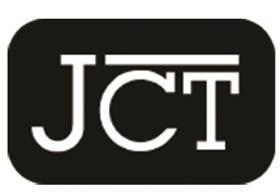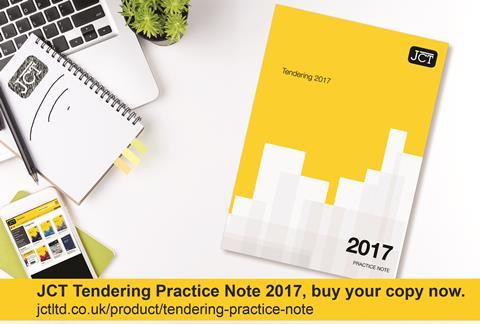Procurement contracts can be complicated to arrange and have many risks attached. This CPD, sponsored by the JCT, is a guide to the different contract options available
CPD CREDITS: 60 MINUTES
DEADLINE: 27 JULY 2018
For more information about Assemble Media Group’s CPD distance-learning programme, click here


INTRODUCTION
This CPD draws on information provided by the Joint Contracts Tribunal and focuses on project strategy around procurement.
Procurement is a generic term embracing all those activities undertaken by a client seeking to bring about the construction or refurbishment of a building. Procurement is initiated by devising a project strategy, which entails weighing up the benefits, risks and financial constraints attending the project, which eventually will be reflected in the choice of contractual arrangements.
In every project, the concerns of the client will focus on time, cost and performance or quality, in relation both to design and to construction of the building.
The project strategy requires an analysis of the situation, making a choice from the procurement options and then devising a method of implementing that choice, using well established rules and procedures. The client’s policies, available resources, organisational structure and preferred contractual arrangements will need to be taken
into account.
There are inherent risks associated with using any particular procurement strategy but equally important is the need for all parties to comply with their respective obligations – this is particularly important where responsibility for design and construction are separated. Identifying and dealing appropriately with risk at the outset is an integral part of any project strategy.
PROCUREMENT
There are three main procurement options:
Traditional procurement
A method that became standard practice in the building industry for 150 years following the emergence of the general contracting firm and the establishment of independent client consultants. The main feature is that the design process is separate from construction, and full documentation is required before the contractor can be invited to tender for carrying out the work.
Design and build procurement
A method where the contractor is responsible for undertaking both the design and the construction of the work in return for a lump-sum price. There are variants on this option depending on the degree to which initial design is included in the client’s requirements.
Management procurement
A method where overall design is the responsibility of the client’s consultants, and the contractor is responsible both for defining packages of work and then for managing the carrying out of this work through separate trades or works contracts.
Management procurement can take a variety of forms. With management contracts, the client appoints a full professional team and a management contractor who is responsible for managing the carrying out of the works. The management contractor does not directly undertake any of the construction work, which is broken down into packages and carried out by works contractors. These are appointed by the management contractor, to whom they are directly and contractually accountable.
Construction management is a type of management procurement where the client appoints a design team and enters into an agreement with the construction manager, or appoints an in-house manager. The construction manager does not directly undertake any of the construction work, which is broken down into packages and carried out by trade contractors, who are appointed by the client to whom they are directly and contractually responsible. The client therefore assumes a major role in directing the project, leaving the management of it to the construction manager.
With “design and manage” procurement, the management contractor assumes both the responsibility for managing the works packages and for the design team.

TYPES OF CONTRACT
Traditional
There are three main types of traditional contract:
- Lump sum contracts – where the contract sum is determined before construction work is started. The contractor undertakes a defined amount of work in return for an agreed sum.
- Measurement contracts – where the contract sum is not finalised until after completion, but is assessed on remeasurement to a previously agreed basis.
- Cost reimbursement contracts – where the sum is arrived at on the basis of prime (actual) costs of labour, plant and materials, to which there is added an amount to cover overheads and profit.
Design and build
There are three main types of this contract:
- Package deal or turnkey contract – where the client settles on a complete package, usually to some standard specification from a commercial firm.
- Design and build contracts – where project documents will be written with the contractor’s design obligations relating to the whole of the works in mind.
- Contractor’s design for specific elements only. Strictly, these are not design and build contracts, but traditional “work and materials” contracts which include for limited design provision relating to an identified portion of the work.
Management
For management procurement there are two main types of contract, although variants do exist:
- Management contracts – where the management contractor undertakes to manage the carrying out of the work through works contractors, who are contractually accountable to the management contractor. The contract will usually include both a pre-construction phase and the construction phase.
- Construction Management – where the construction manager undertakes to manage the carrying out of the work through trade contractors but the client is involved in the directing of the project, and the contracts with the trade contractors are directly with the client.
MATTERS THAT MIGHT INFLUENCE CHOICE
The choice of an appropriate procurement method and type of contract might be greatly influenced by external factors. Choice should never be made on an arbitrary basis but always after a careful analysis of the situation, and taking into account considerations including the following:
- The nature of the project: is this a completely new detached building; an extension to an existing building; a refurbishment job; restoration of an historic structure; reinstatement after fire damage or neglect; or a repair and maintenance programme involving many buildings?
- The scope of the works: is there something unusual about the size, complexity or location of the works; are there site problems of access, storage or movement; does it involve the basic trades and skills of the industry; does an innovative design demand sophisticated construction methods; is there specialist subcontractor’s work with a design content; is there a high content of specialist engineering installations; is this a single operation, phased work, or part of a term programme?
- Accountability: does the client aim for single-point responsibility; is it the intention to appoint a project manager or client’s representative; where is responsibility intended to lie for specific matters – with consultants, contractor, specialist subcontractors?
- Appointment of a contractor: is this to be by negotiation or by competitive tendering; is the contractor to be appointed to carry out construction work only; is the contractor to have some responsibility for design; is the contractor to be appointed early to undertake primarily a management role?
- Certainty of final cost: for example, is a lump sum contract preferred; will it be a fixed price or with fluctuations; do the circumstances dictate remeasurement and an ascertained final sum; must all tenders be on a competitive basis?
- Assessment of risks: is this to be a contract with the lowest possible risk to the client overall; what are the priorities in apportioning the risks concerning cost, time, and quality or performance; where are the speculative risks intended to lie?
CONSEQUENCES OF CHOICE OF MAIN CONTRACT
Among the consequences that may follow from the selection of the procurement method and the JCT contract thought most appropriate, the following are worthy of mention:
Composition of the team
The form of contract, when completed, will confirm who is to undertake certain specific duties and accept certain obligations. For instance, the extent to which construction and design responsibilities are allocated between the professional consultants, the main contractor and specialist subcontractors should be evident from the provisions of the contract.
Compatibility of agreements
It is essential, however, that what might be required of the professional consultants as expressed in the building contract is also reflected in the schedules of professional services included as part of the appointing documents for those consultants.
Documents for tendering purposes
With traditional procurement, the realism (or otherwise) of lump sums obviously depends on tenders having been prepared on the fullest possible information. Where that information is unlikely to be available at pre-construction stage, lump sum contracts are unlikely to be satisfactory and alternatives will have to be considered.
JCT documents generally do not include tender procedures covering tenders for the main contract works, but where the main contract conditions refer to the use of specific documents, for example, the naming of persons as subcontractors (Intermediate Building Contract – IC) or the use of works contractors (Management Building Contract – MC), there is a requirement that such tenders be invited in accordance with the relevant documents.
The contract sum
Use of a Standard Building Contract With Quantities should ensure that all tenderers are using the same quantities. Unless stated otherwise in respect of any particular items, the contract requires the contract bills to have been prepared in accordance with the RICS New Rules of Measurement. The accuracy of the quantities is the employer’s responsibility, and the contract provides for the correction of errors with appropriate adjustment of the contract sum. The contract sum is the total arrived at in the fully-priced copy of the itemised contract bills.
Where the Standard Building Contract Without Quantities is used, then, in addition to the contract drawings, the other required document(s) will be either a specification or work schedules. The specification or work schedules should be itemised in enough detail for the contractor to price, and the total of the pricing will be the contract sum.
Alternatively, the contractor may state the sum required to carry out the work, in which case either a contract sum analysis or a schedule of rates on which the contract sum is based, also referred to as the priced document, should be supplied. The priced document then forms the basis for the valuation of any variations and of work carried out under provisional sums.
There may be a reluctance on the part of contractors to tender without quantities where the project exceeds a certain size or complexity. The risk of error is largely borne by the contractor, and tenders may be increased to cover preparation costs and possible disputes over the quantity of work implied in the contract documents.
JCT contracts for smaller, more straightforward projects seek to avoid, and do not recognise, a need for any ancillary documents. These contracts, like the Minor Works Building Contract, accept that domestic sub-contracts may be necessary; they do not stipulate the use of any particular form, but only that whatever form is used it must include certain provisions stated in the main contract.
Other JCT contracts for larger work require the use of sub-contracts specifically published for use with the particular main contracts; for example, the Intermediate Named Sub-Contract documents, where the subcontractor is a “named person” under the Intermediate Building Contract (ICSub/NAM documents), and the Management Works Contract documents, for a Works Contractor under the Management Building Contract (MCWC documents).
For the employer, most JCT contracts state that the employer has had certain contract documents prepared; the type of documents that are relevant will depend on the form of contract used. Except for some contracts for smaller works, the Design and Build Contract and the Major Project Construction Contract, the employer is obliged to appoint a professional consultant to administer the terms of the contract.
Under the Design and Build Contract, the employer may appoint someone to act on their behalf. Contracts may refer to the administrator as the architect, contract administrator or, as in the Design and Build Contract, the employer’s agent.
All construction work including domestic projects will be subject to the Construction (Design and Management) (CDM) Regulations 2015. For further guidance on the regulations generally, go to: www.hse.gov.uk/construction and for industry guidance: www.citb.co.uk/cdmregs.
With all JCT contracts the employer should be satisfied that any desired optional clauses and supplemental provisions have been properly incorporated to indicate their intentions, that the agreement has been properly completed, and that the contract is properly signed or otherwise executed before construction work commences.
For contractors, the consequences of entering into a particular contract are that they must carry out and complete the work in accordance with the terms of that contract. Depending on these terms, they may submit their own valuations; be required to submit design proposals for part of the work; be required to carry out performance specified work; or be obliged to sub-let work to specified, ie named, subcontractors.
Contractors will be obliged to complete on or before the completion date stated in the contract, but where work is subject to sectional completion, each section must be completed by the completion date entered for that section.
There are various obligations arising from statute, some of which will be implied in the terms of the contract, and others expressly stated. For example, responsibility for obtaining the necessary planning consents or building regulations approvals will normally rest with an employer through their professional consultants.
Nevertheless, the contractor will still be liable for compliance with statute in respect of building law. Health and safety law, and in particular the CDM Regulations 2015, impose statutory obligations on the employer, designers and the contractor. In addition to being statutory matters, some are also incorporated as contractual obligations in JCT contracts.
All editions of JCT contracts dated from 1998 onwards take account of the Housing Grants, Construction and Regeneration Act 1996 (“the Construction Act”), except for the home owner/occupier building contracts. The current 2016 editions of JCT contracts reflect the amendments to the Construction Act made by the Local Democracy, Economic and Construction Act 2009, in so far as they relate to payment terms and payment-related notices.
The home owner/occupier building contracts are for use by a residential occupier and a construction contract with a residential occupier is excluded from the provisions of the Construction Act. They, however, include adjudication provisions even though the act does not require them for residential occupiers.
WATCHPOINTS FOR CHOICE AND USE
Choice
Check whether the JCT contract under consideration is appropriate for the procurement method adopted, and that the provisions it contains are likely to prove adequate for the particular circumstances. Remember that in JCT contracts, design obligations can be imposed upon constructors in various ways, such as by selecting the optional integrated provisions such as those contained in the Standard Building Contract and by using the Intermediate Named Sub-Contractor/Employer Agreement.
Use
JCT contracts are intended to be read as a whole, and ill-conceived amendments can produce unintended results when construed at law. Ad hoc amendments should be avoided as far as practicable, particularly on points of substance.
- JCT contracts are intended to be, and are generally accepted as being, fair and evenly balanced between the parties for the projects for which they are designed. This balance should not unwittingly be put at risk.
- Check that the provisions for insurance are likely to prove suitable in the particular circumstances. Exceptional circumstances, such as contaminated land, might dictate that special arrangements have to be made, which the employer will need to discuss with insurance experts and which the parties to the contract will need to agree.
- Where employer’s requirements are required, sufficient time should be allowed for preparation, so too for examination of the contractor’s proposals.
- Check that the JCT contract particulars and all contract documents are fully completed, and that the Agreement has been signed or otherwise executed before the date for the commencement of the works.

How to take this module
Assemble Media Group’s CPD distance-learning programme is open to anyone seeking to develop their knowledge and skills. Each module also offers members of professional institutions an opportunity to earn between 30 and 90 minutes of credits towards their annual CPD requirement.
This article is accredited by the CPD Certification Service. To earn CPD credits, read the article and then click the link below to complete your details and answer the questions. You will receive your results instantly, and if all the questions are correctly answered, you will be able to download your CPD certificate straight away.
CPD CREDITS: 60 MINUTES
DEADLINE: 27 JULY 2018
Privacy policy
Information you supply to Assemble Media Group Limited may be used for publication and also to provide you with information about our products or services in the form of direct marketing by email, telephone, fax or post. Information may also be made available to third parties. Assemble Media Group Limited may send updates about Building CPD and other relevant Assemble Media Group Limited products and services. By providing your email address you consent to being contacted by email by Assemble Media Group Limited or other third parties. If at any time you no longer wish to receive anything from Assemble Media Group Limited or to have your data made available to third parties, contact the Data Protection Coordinator at building@building.co.uk. View our full privacy policy at www.building.co.uk/cpd

















No comments yet